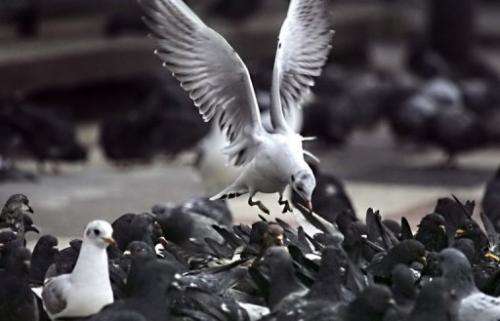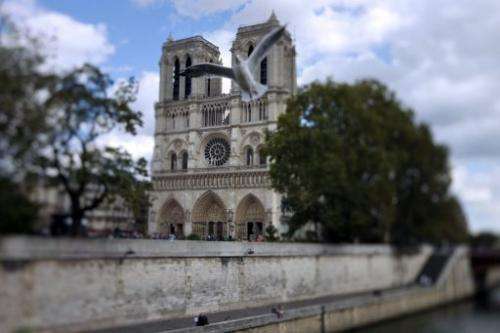A seagull flies over pigeons, 20 February 2006 in Paris. A two-hour drive from the French coast, Paris sets up an artificial seashore on the banks of the Seine each summer and while the beach may be fake, the seagulls overhead turn out to be real.
A two-hour drive from the French coast, Paris sets up an artificial seashore on the banks of the Seine each summer and while the beach may be fake, the seagulls overhead turn out to be real.
And the birds don't leave when the stretches of sand and deckchairs are removed ahead of the autumn chill.
Natives of the Atlantic coast, these herring gulls—with their white head and body, grey wings, yellow beak and ear-piercing shriek—have found a surprising new home in the City of Light.
"You can't really call it a population explosion," according to Frederic Malher, deputy head of the city's ornithological centre who said there are about 50 breeding pairs now in central Paris.
But attracted by warmer temperatures and ready food, they offer an incongruous—and not always welcome—presence on the tall Haussmannian buildings where their nests are perched and which Malher said the gulls probably mistake for seaside cliffs.
For more than a century, Paris has been a part-time home for the much smaller black-headed gull (Larus ridibundus)—a river bird that overwinters in city parks before heading home to eastern Europe each March.
But the herring gull (Larus argentatus) is now a year-round resident and even nests here, said Malher.
Concentrations of the birds are today found in the historic central Marais district, around the national archives and in a neighbourhood near the Montparnasse skyscraper that on the Left Bank.
In 1989, a captive female at the Jardin des Plantes botanical garden and a wild male were one of the first pairs to hatch eggs in Paris.
The Paris herring gulls today have between one and three offspring per pair per season, but a very high death rate explains why the population is only growing slowly.
Picture taken with a tilt and shift lens shows a seagull flying in front of Notre-Dame de Paris cathedral on September 19, 2011 in Paris. A two-hour drive from the French coast, Paris sets up an artificial seashore on the banks of the Seine each summer and while the beach may be fake, the seagulls overhead turn out to be real.
The herring gull is big—an adult has a wingspan of 1.5 metres (4.9 feet).
Its original diet included fish and shellfish, even small birds, but in town the gull feeds on "pretty much anything," according to Malher.
Peter Rock, an ornithologist and urban gull expert in Bristol, England, said herring gulls are moving to cities attracted by easy pickings offered by rubbish tips, an absence of predators and warmer temperatures.
"In town, the temperature is between four and six degrees C (7.2 and 10.8 degrees F) warmer than the surrounding countryside. It makes things quite a lot easier for the breeding season," he explained.
As in Britain, the birds abound in French coastal towns like Dieppe, Lorient or Brest, where hungry seagull flocks pester restaurant terraces.
Experts say herring gulls pose no real threat but cause much annoyance with their cries and tearing up of trashcans.
The gulls cause damage to buildings—when posturing to avoid a fight they have the habit in th e wild of pulling out big clumps of grass, but in the city it is roofing felt, pipe insulation and waterproofing materials that fall victim.
Paris city hall says it has so far received only received a handful of complaints, mainly from residents irked by the noise.
Herring gulls have a high-decibel cry, "Iyo iyo iyo GA-GA-GA-GA-GA," which they tend to utter in a group, especially at sunrise—something that is not popular in a city where quiet and sleep are prized.
"When you hear it, you think that the racket is being made by three or four birds and it turns out that just one bird is doing it," said Malher.
Rock, whose city has a big population of herring gulls, agrees.
"The major complaint is from the noise. It goes on all day and all night with a particularly loud response to the dawn," he said.
"I suppose the second-most complained-about thing is the white stuff that comes out of their rear end."
Herring gulls are a protected species in France, as in Britain, and it is an offence to kill the bird.
But authorities in some cities where they have become a pest can obtain special permission to sterilise eggs in the nest by covering them with varnish to suffocate the embryo.
© 2013 AFP






















